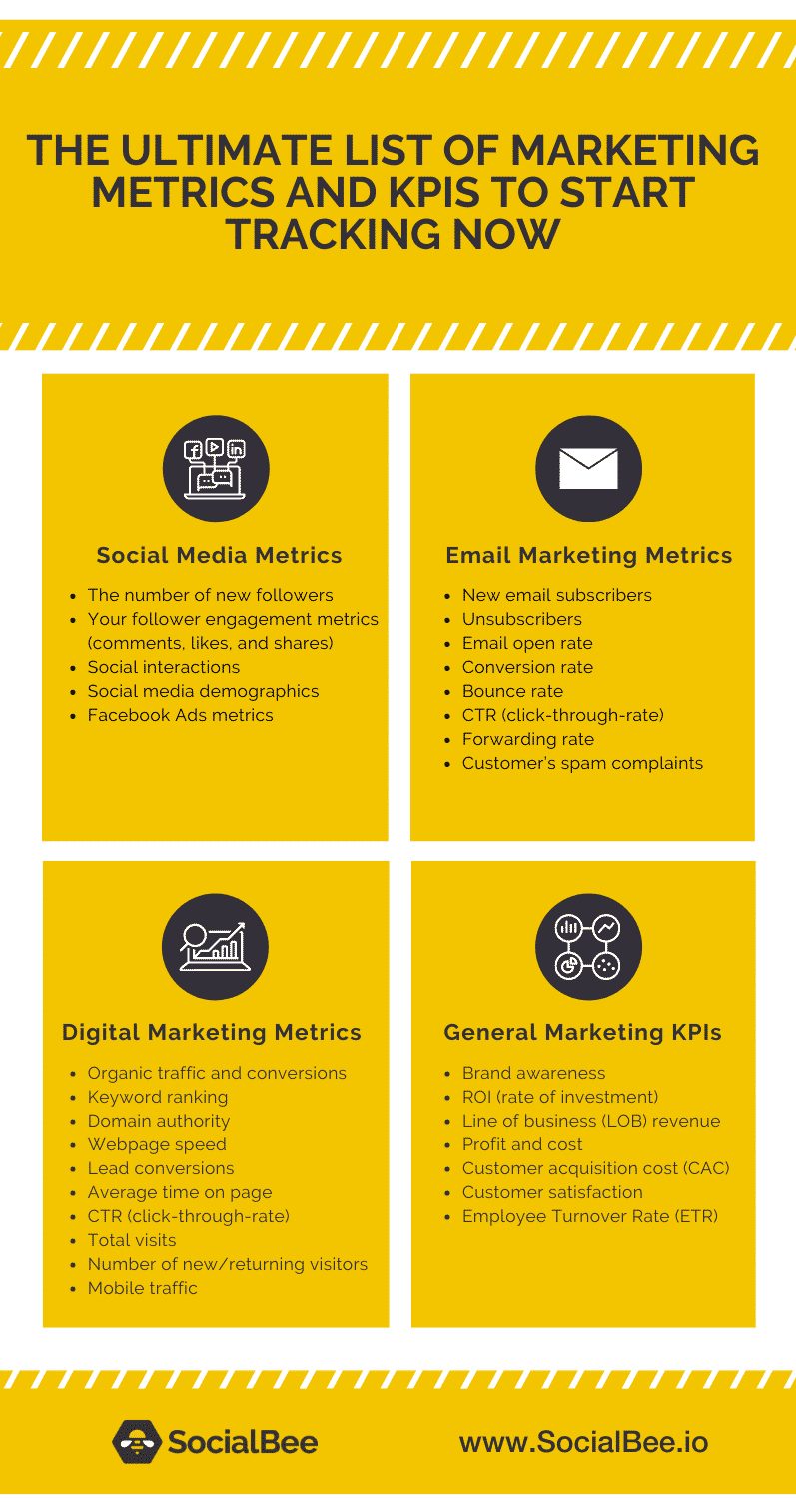
Adelina
CONTENT WRITER
Let’s be honest — most of us hated being tested in school. After all, testing usually brings forth a lot of anxiety and there isn’t really a one-size-fits-all when it comes to measuring overall performance in school.
Luckily, testing your performance with a marketing report template in your campaigns is much more successful and less stressful than testing performance in school.
Okay, but how do you test and track the performance of marketing campaigns? 🤔
By taking a look at your chosen marketing metrics and KPIs (key performance indicators).
What Are Marketing Metrics?
Although the name is pretty self-explanatory, let’s take a look at the definition and get a more clear idea of what marketing metrics are:
Marketing metrics are measurable values that marketers use in order to track the performance of their marketing campaigns.
Using these metrics you will be able to monitor and measure the development of your marketing projects. Generally speaking, marketing metrics are different from platform to platform or from project to project.
For example, you can’t apply a marketing metric used for a social media campaign to an email marketing campaign. These two campaigns need different metrics that need to be taken into consideration.
So while on social media you will take notice of the number of new followers your page has, in your email marketing campaign you will look at how many new people have signed up for your newsletter.
What Are KPIs?
A KPI or a key performance indicator is a measurable value that can show how efficient is a business in achieving its key objectives.
Although marketing metrics and KIPs seem similar by definition, there is one difference.
Marketing metrics deal with measuring the progress and success of marketing campaigns. KPIs on the other hand measure the progress and success of the entire business, which means that these metrics go beyond the companies’ marketing scopes and goals.
For example, marketing metrics include the number of visitors your website has in one month. KPIs can include values that refer to the lifespan of customers, the free cash flow, the number of sales by product or service, etc.
Although different, these two terms have been used interchangeably. And looking at the bigger picture, we can say that marketing metrics are part of KPIs, but it’s a good idea to keep the distinction between the two in mind.
Why Are Marketing Metrics and KPIs Important?
As a business owner, you need marketing metrics to track the progress of your campaigns and see the success rate of each project in part.
Therefore, by keeping track of your marketing metrics and your KPIs, you will be able to keep a record of:
- Which department needs more attention and improvement
- Which marketing campaign is most successful
- Which projects you should drop
This way, you will know exactly which projects you should concentrate on and what marketing tactics you need to adopt in order to increase your success rate.
All in all, marketing metrics and KPIs are very important for the well-being of your business. But with so many campaigns, projects, and departments that are in need of supervision, how will you know which ones you should be keeping a close eye on? 😱
We’re here to answer that inquiry and tell you exactly why you should invest your time and resources in the following marketing metrics and KPIs.

1. Social Media Metrics
Many people believe that marketing on social media is easy. After all, you just have to post some tweets and share some content on Facebook and you’re done, right? Wrong. 🙅♀️
There’s a lot more than meets the eye when it comes to social media marketing. You need to carefully craft content for each platform in part, make sure you use the appropriate amount of keywords, see that the content reaches the right audience, etc.
And of course, to do that successfully, you will have to track a couple of metrics, such as:
- The number of new followers on each platform
- Your follower engagement metrics
- The number of comments, likes, and shares
- Social interactions
- Social media demographics
- Facebook Ads metrics
To get your hands on these values, you will need a good social media analysis tool. We recommend SocialBee due to several reasons. By using SocialBee, not only will you be able to get information about the status of your audience and your top-performing posts, but you also have the option to automize your social media posting.
This tool will allow you to customize your posts for each platform in part and schedule the posting time of your content, therefore cutting down on the time that could be invested in other things.
If you want some more in-depth information on your social media accounts, you can use the integrated analytics sections that most social media platforms offer.
2. Email Marketing Metrics
Who even reads emails anymore? Well, according to recent studies, quite a lot of people! Research shows that email marketing delivers an average ROI of 4400%, with a $44.25 return for every single $1 spent.
So if your demographic allows it, email marketing is a must. But in order to have successful email marketing campaigns, you need to track them right from the beginning and see what works and what doesn’t.
Here are the main metrics that you should keep an eye on:
- New email subscribers
- Unsubscribers
- Email open rate
- Conversion rate
All four of these are important when it comes to having great email campaigns. You don’t only want to have more subscribers, but you also want your subscribers to find your emails worthwhile.
Get the Latest Social Media Updates!
By keeping track of these metrics you will be able to notice the subtle differences and see what email marketing strategy works best for your business. Perhaps your subscribers react better to promotional emails, so you should increase these types of emails. You can easily see this if you track your email marketing campaigns.
Some other metrics that you might find worth investing in are:
- Bounce rate
- CTR (click-through-rate)
- Forwarding Rate
- Customer’s complaints about spam
To get your hands on any of these metrics, there are certain formulas that you can use. For example, to get the CTR, you will have to take the total number of clicks, divide it by the number of emails that you’ve sent and then multiply it by 100. So the formula is going to look like this:
(Total number of clicks/ Total number of sent emails) X 100
The result is going to be the percentage of your CTR.
Ultimately, you should check all of these metrics once in a while, but you need to keep a constant eye on the main email marketing metrics.
3. Digital Marketing Metrics
When it comes to the digital space, there are a lot of things that you should keep in mind. The most important of those things is your website. According to a study performed by Stanford, 75% of users admit to making judgments about a company’s credibility based on its website.
So yes, when it comes to converting leads and scoring sales, your SEO efforts and your website’s design matter a lot.
Keeping track of SEO and website metrics will ensure that you know what kind of content on your website gets the most traction. Not only that, but if you play the SEO game right, you will get more leads clicking on your website, which will eventually lead to more conversions.
But because SEO and digital marketing are pretty complex, this means that there will be a lot of metrics that you need to track. Here are the ones that we deem most important:
- Organic traffic and conversions
- Keyword ranking
- Domain authority
- Webpage speed
- Lead conversions
- Average time on page
- CTR (click-through-rate)
- Total visits
- Number of new visitors and of returning visitors
- Mobile traffic
These are just a handful of the things that you should be tracking when you have a website. Generally speaking, tracking SEO metrics and improving your SEO strategy can be done by using an array of tools.
For example, if you want to perform keyword research (which is definitely something that you should do) you can use tools such as Wordtracker. Or if you’re into PPC (pay-per-click) and you’re using Google Ads, you can take a look at the keyword research tools that Google offers.
All in all, once you have your tools, you can get ready to measure your SEO performance and improve it considerably.
4. General KPIs
Now that we have discussed marketing metrics, let’s take a look at some more business-specific KPIs. As you might already know, a business needs to monitor a lot of metrics in order to make sure that everything is going according to plan.
After all, you want your company to meet its yearly and quarterly goals and this can be done only by closely supervising the development of each department in part.
The KPIs that you should always be something that you look after are the following: 👇
- Brand awareness
- ROI (rate of investment)
- Line of business (LOB) revenue
- Profit and cost
- Customer acquisition cost (CAC)
- Customer satisfaction
- Employee Turnover Rate (ETR)
If the previous metrics measure performances in marketing, then these metrics measure the performance of the sales, management, customer service, and HR departments.
Each department is in charge of tracking its own KPIs and making sure everything is within working parameters. But if you want to have an overview of your business’ functionality, you can start by checking out the aforementioned metrics and seeing if they are in accordance with your goals.
As for many other metrics, there are certain formulas that you can use to calculate the resulting values. For example, if you want to see the profits your company is making, you can take the total revenue and deduct the expenses.
How can you calculate your revenue? You take your total sales and multiply it by the average price per service or product.
Sales X Average Price per Product → Revenue
Once you find the right formula for your KPIs, getting the values you need becomes a breeze.
Bottom Line
Now, you might think that these are a lot of metrics that you need to track, and you’re right. But although tracking these KPIs and these metrics is important, you ultimately need to see which metrics are vital for your business.
Make sure you find a balance and track the KPIs that can bring significant improvement to your business. Don’t forget that tracking and looking for solutions is a team effort, so make sure that each department does its part. 🤝













